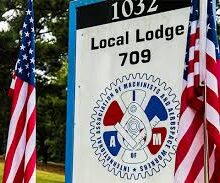
Local Lodge 709 proudly represents Factory and Office & Technical employees of Lockheed Martin at Air Force Plant #6 in Marietta, Georgia. We currently representover 2000 members that build the most advanced military aircraft in the world. These programs currently include, the C-130J, JSF/ F-35 Mid Body, F-22 Mod program, and the ADP program. Earlier programs that have been completed by our members, include the C5 Galaxy Production and assembly, C-5 engine Mod,F-22 Production and assembly, Mod programs for the P-3 (wings).
Our Members take pride in their workmanship, building, modifying, and testing the finest military aircraft in the world. Local Lodge 709 has been a staple of both Marietta and surrounding communities for over 60+ years (September 26, 1961- Current). Local 709 aims to serve our membership through collective bargaining that includes comprehensive pay, benefits, a safe workplace free from discrimination, harassment, or any other unwarranted action in the workplace. Local 709 uses volunteers in their efforts to serve the surrounding community and organizations.
Through the years, Local 709 has bargained countless contracts, successfully fought for worker equality, and joined our leadership on the front lines fighting for our Union principles. Our appointed legislative committee lobbies with local and state politicians to raise the bar for worker rights and the opportunity for a better life for workers and their families. For more information on how to form a Union or for more facts, our Local is located at 1032 South Marietta Pkwy. SE, Marietta, Ga. 30060. TY
